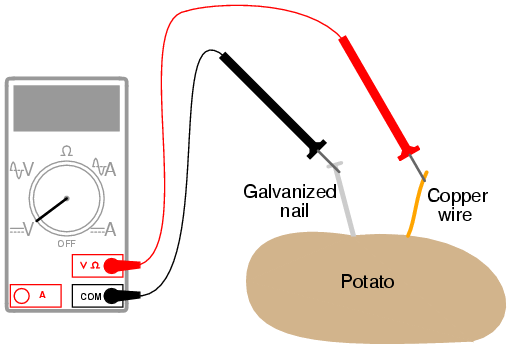Potato battery
PARTS AND MATERIALS
- One large potato
- One lemon (optional)
- Strip of zinc, or galvanized metal
- Piece of thick copper wire
The basic experiment is based on the use of a potato, but many fruits and vegetables work as potential batteries!
For the zinc electrode, a large galvanized nail works well. Nails with a thick, rough zinc texture are preferable to galvanized nails that are smooth.
CROSS-REFERENCES
Lessons In Electric Circuits, Volume 1, chapter 11: "Batteries and Power Systems"
LEARNING OBJECTIVES
- The importance of chemical activity in battery operation
- How electrode surface area affects battery operation
ILLUSTRATION

INSTRUCTIONS
Push both the nail and the wire deep into the potato. Measure voltage output by the potato battery with a voltmeter. Now, wasn't that easy?
Seriously, though, experiment with different metals, electrode depths, and electrode spacings to obtain the greatest voltage possible from the potato. Try other vegetables or fruits and compare voltage output with the same electrode metals.
It can be difficult to power a load with a single "potato" battery, so don't expect to light up an incandescent lamp or power a hobby motor or do anything like that. Even if the voltage output is adequate, a potato battery has a fairly high internal resistance which causes its voltage to "sag" badly under even a light load. With multiple potato batteries connected in series, parallel, or series-parallel arrangement, though, it is possible to obtain enough voltage and current capacity to power a small load.
